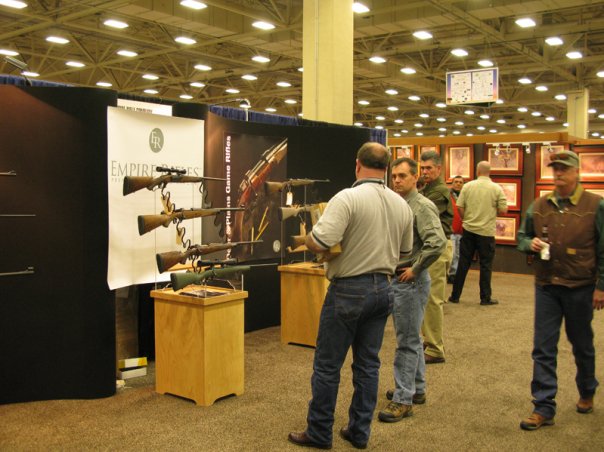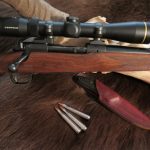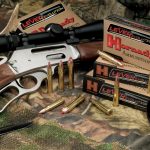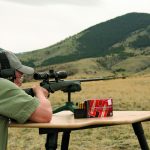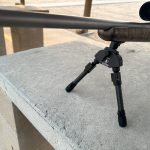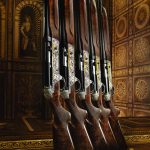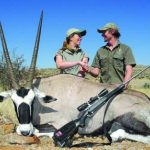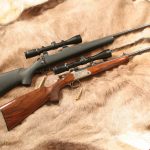Iron sights are still useful in some hunting situations.
I’ve written about iron sights before. It seems me that, in these days of almost universal scope use, shooting with iron sights is almost a lost art. This is regrettable for two reasons. First, in order to use iron sights properly, precision and consistency are required in centering the front sight blade or bead in the aperture or rear sight. It’s essential to see it the same way and do it the same way every time, or the shots can go really wild. These lessons absolutely apply to shooting with scopes or reflex (red dot) sights, so to my thinking an entire lifetime of shooting is enhanced by first learning to shoot a rifle with iron sights.
Most shooters of my generation started out with open-sighted BB guns and then .22s, used for some combination of plinking, more formal target shooting, and small game hunting. Regrettably, many kids of recent generations have started with scopes. This includes my own daughters, so that’s a failing on my part both as teacher and Dad. Iron sight to scope is an easy transition. Scope to iron sight is not so easy and, as I’ve written before, shooters with decades of scope use under their belts don’t suddenly wake up with magical proficiency with iron sights.
Iron sights are of essentially two types: Open; and aperture or “peep” sight. An open rear sight, customarily barrel-mounted, requires the eye to focus in three planes: Rear sight, front sight, and target. The aperture sight is easier on the eye because the rear opening or aperture can be “fuzzed out,” requiring the eye to focus on two planes: Front sight and target. This is generally a more precise sight because the eye naturally attempts to center the front sight in the aperture and, for older eyes, the two-plane issue is easier because the front sight is farther from the eye than the rear sight. (There are natural reasons why, at some point, most of us need reading glasses, but most of us retain reasonable distance vision). A properly focused scope allows us to superimpose the reticle over the target, requiring the eye to focus in just a single plane, at the target.
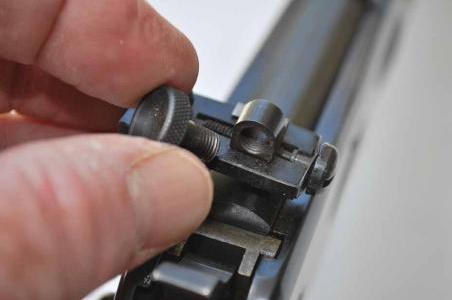
The aperture sight is actually an optical sight with the eye naturally centering the front sight in the opening. Precision is determined largely by the size of the opening; a “ghost right” aperture simply uses the larger hole with the aperture removed.
As our eyes age and the ability to focus in multiple planes decreases, quickly and properly resolving iron sights becomes more difficult. This is greatly aided by stock fit. Provided the rifle comes up on target it isn’t always necessary to perfectly resolve the iron sights, especially at close range. So, despite the limitations, I remain convinced that there are certain applications where iron sights are superior to scopes. Traditionally, in my mind, these have included hunting very large game at extremely close range—all elephant hunting and some extremely close-cover buffalo hunting; hunting in a driving rain or blinding snowstorm, where scope lenses are obscured almost instantly; and most hound hunting.
As with elephant hunting, in hound hunting the ranges are usually very short, so the problem is the “tunnel vision” created by use of a scope, but for different reasons. With elephant, and to a less extent a buffalo at very close quarters, there are two issues. First, seeing only a wall of gray or black in the field of vision, and thus having more difficulty rather than less in visualizing the aiming point. Second, with elephants the real danger is often from other elephants rather than the targeted animal, so peripheral vision is critical. With hound hunting the danger is twofold: Whether the animal is bayed or treed, the shot must be certain to preclude a wounded animal mixing with the dogs; if the animal is bayed, then the shot can only be taken when the dogs are absolutely clear, so peripheral vision is again critical.
In general I hold to these principles, but some recent experiences on the one hand reinforce—and on the other hand negate—these long-held concepts. In September I took what was, for many reasons, probably my last elephant. Back in 1985 I took my first elephant, using a .416 with fixed 3X scope. In 2015 I also used a .416, this one with a Leupold 2-7X turned down all the way. In between, for thirty years, all my elephants were taken with iron sights. This last elephant, taken in the Caprivi, was in some of most open country I have ever hunted elephant in. Just looking at the open grassland and scattered patches of cover, I expected an extremely long shot which, in elephant hunting, means maybe forty yards. The Rigby I carried had good iron sights, practiced with and zeroed, so I could have (and should have) removed the scope, but I didn’t. I drew a frontal brain shot at twelve yards, too close for optimum scope use. It worked, but validated my belief that iron sights remain superior for elephant hunting.
The next lesson came in Idaho toward the end of 2015. Donna and I were hunting cougar with veteran houndsman Bruce Duncan. Donna is competent with iron sights, but much more confident with a scope. She intended to use her extremely light MGA .270 with the 3.5-10X scope turned all the way down. Unlike many houndsmen, Duncan doesn’t insist on iron sights only, but he would have his old friend Gertie along just in case. Gertie is a well-worn ’94 Winchester .30-30, both stock and barrel shortened. It has accounted for hundreds of cougars and black bears in his thirty-year career. If I got a chance (only after Donna) I intended to use Gertie.
Donna’s cat treed in a very tall tree, only a sliver of vitals exposed and only with a near straight-up shot. Maybe the shot could have been taken with iron sights, but I’m really glad I didn’t have to try! Just a day later my own shot was even worse, taller tree, steeper angle, branches obscuring part of the chest. I could have hit the cat somewhere with iron sights, I guess, but Gertie’s front sight covered most of the cat and both branches I needed to get past. I switched to a scoped rifle; even though it was a close shot over hounds I needed the single-plane focus of a scope. So let me modify my long-held belief: Iron sights are suitable for most hound hunting, but not for all potential shots.
I suspect that few of us actually hunt with iron sights these days, but most of us have “auxiliary” iron sights on some of our rifles, and we have childlike faith in their strength and durability. My own M94 .30-30 is a short-barreled Trapper. Long fitted with a Lyman receiver sight, it has always been extremely accurate, but I don’t use it much. The other day I took it to the range and discovered (to my horror) that the aperture base was bent, and the strike at fifty yards was four inches high and three inches left.
Very few current iron sights are invincible, so if you intend to actually use them (or even think you might), make sure they’re zeroed with the same diligence you would zero your scope. This is one advantage to the popularity of the AR frame and the so-called “tactical” rifles: “Battle sights” tend to be extremely robust; sporting rifle iron sights are often surprisingly flimsy, in part because today’s makers often don’t expect that they will actually be used. In the case of my ’94, had I taken care to inspect it, the rear sight was visually bent; equally common is for front sights to bend and windage adjustments to be knocked out of kilter. The fix is simple: Retighten or straighten. Then it takes trial and error shooting. If the adjustments are in the rear sight, move the sight in the direction you want the strike of the bullet to move (right for right, up for up). With many battle sights, elevation adjustment is in the front sight; move the sight in the opposite direction you want the strike to move (up for down). Don’t ever take it for granted that iron sights are “on!”

